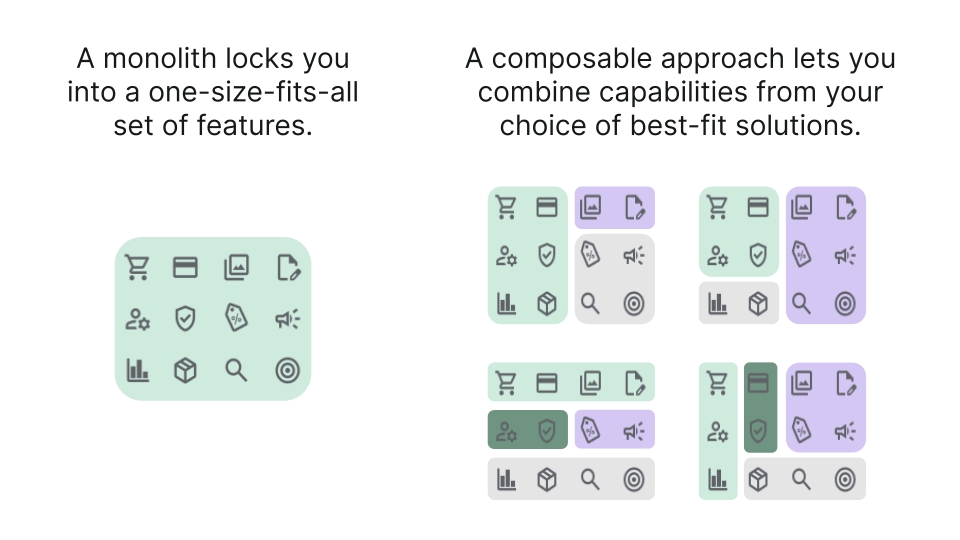Composable commerce is one of the most exciting developments in online shopping today, transforming how businesses create and scale their systems, and setting a new standard for flexibility and innovation in the digital commerce world.
Composable isn’t just another buzzword; it’s a transformative approach that delivers a tailored shopping experience for customers and agility for businesses. Its service-oriented nature and synergy with MACH architecture (microservices, API-first, cloud-native, and headless technologies) position it as the future of ecommerce.
In this article, we’ll dive into what composable commerce is, how it compares to traditional systems, and why it’s a must-have for modern ecommerce. Let’s break it down.
The basics: What is composable commerce?
At its core, composable commerce is a software architecture that decouples the frontend (UI) from the backend (business logic) and lets businesses build ecommerce systems using "best-of-breed" technologies. This modular setup communicates via APIs, meaning individual components can be swapped out without disrupting the rest of the system.

In essence, it’s about combining flexibility, speed, and personalization to create a future-proof commerce experience.
MACH architecture: The foundation of composable commerce
MACH architecture – short for Microservices, API-first, Cloud-native, and Headless technology – is a modular approach that empowers businesses to innovate. It enables composable commerce to build on this foundation, going beyond MACH principles to solve specific business needs with ease.
Composable commerce builds on the principles of MACH architecture and takes them a step further. It simplifies the complexity of traditional ecommerce platforms by avoiding the rigidity of monolithic systems.
Instead of locking businesses into a single structure, it offers the freedom to adopt modular solutions tailored to specific requirements. In turn, this modularity empowers brands to pick and integrate the best tools available, creating a stack that works perfectly for what they actually need.
You’ve likely encountered composable commerce without even realizing it. Many tools you use daily fall into this modular approach, such as:
Content Management Systems (CMS);
Standalone solutions for payments, reviews, and search.
Why composable commerce matters
The online commerce market spans industries from fashion to technology, each with its unique customer demands and preferences. No 2 businesses or customers are alike, which makes it impossible for a single solution to meet everyone’s needs.
Delivering personalized, omnichannel experiences
Composable commerce responds to the urgent need for customization and individualization. Different sales channels cater to different types of buyers, and today’s brands need to meet customers where they are.
Modern commerce platforms must manage countless touchpoints – websites, mobile apps, social media, in-store kiosks, and customer support channels – and deliver seamless experiences across all channels, driven by real-time data.
A single desktop version of an online store is no longer enough. Customers shop on a variety of devices – smartphones, tablets, desktops, and social media. To keep up, brands need to deliver consistent and excellent experiences everywhere.
This makes an omnichannel strategy a must for ecommerce. To achieve this, you need solutions that are:
Flexible, and able to adapt to multiple devices and platforms.
Independent, not tied down by rigid technology or single providers.
Composable commerce vs traditional systems
Traditional platforms are most often monolithic applications, which bundle features like payments, catalogs, and order management into a single application.

Downsides of monolithic applications
While monolithic architecture works for simpler needs, it has significant limitations:
Lack of flexibility: Making changes to one part affects the whole system.
Scaling challenges: You can’t scale specific features without scaling the entire platform.
Slow innovation: Adding new features becomes difficult and time-consuming.
A monolithic app is like a one-size-fits-all software that combines all the different parts of an app into one big program. For example, an ecommerce platform might include everything from the web server and product catalog to the ordering system, payment function, and shipping components, all in one app.
While this setup can seem convenient at first because everything is in one place, it has its downsides.
The code becomes really complicated and hard for developers to work with, which slows down development. Plus, if you need to make changes to just one part of the app, like the product reviews, you have to update the entire system.
Even though a monolithic app might have a lot of features, not all of them are always top-notch. For example, the checkout system may not have the payment options you need, even though it’s part of the larger app.
A composable architecture, on the other hand, uses an approach that Gartner defines as Packaged Business Capabilities, i.e. "software components that represent a well-defined business capability." With modular, pre-built components designed to solve specific business challenges, businesses can innovate faster and more efficiently.
These bundled business functions serve as building blocks of larger app suites, all connected by API. Each bundled business function is a feature or capability of the app and is typically a third-party software component.
Microservices and composable commerce: A perfect match
Microservices are independent, modular applications that perform a specific function within a larger system. Unlike traditional monolithic architectures, where all components are tightly coupled, microservices allow each service to operate, scale, and evolve independently.
In the context of composable commerce, microservices serve as the building blocks that enable businesses to create flexible and scalable ecommerce solutions. Instead of running everything through one massive system, microservices break things down into smaller, independent apps that handle specific tasks.
For example, one microservice might manage your product catalog, another could handle payments, and a different one can focus on personalized recommendations. These services work together but stay separate, so you can tweak or replace them without disrupting the whole operation.
Composable commerce is all about combining the best tools and services to create an ecommerce system perfect for your needs.
Microservices make this possible, as you can use them to:
Mix and match best-of-breed solutions, like integrating a third-party recommendation engine with an in-house payment processor.
Allow your teams to have full control over the customer journey, creating personalized experiences by combining various microservices into unique workflows.
Respond faster to market trends by replacing or enhancing individual components without overhauling the entire system.
Benefits of composable commerce
Composable commerce architecture has a lot to offer, from giving businesses the flexibility to adapt quickly to saving costs and streamlining processes. Let's break down the main advantages to see why this approach has gained so much popularity.
1. Developer-friendly systems
Composable commerce is designed with the developer in mind, enabling greater flexibility and faster innovation. Since businesses can build and customize their ecommerce platforms using independent, modular components, the composable commerce approach allows development teams to work on different parts of the system without interfering with one another.
Each component can be developed, tested, and deployed separately. This means updates or improvements to one module won’t disrupt the others, making the entire development cycle smoother and faster.
Developers can also choose the best tools and technologies for each component of the platform. This flexibility leads to optimized performance and scalability, as teams are not locked into a one-size-fits-all solution.
2. Reduced operational costs
One of the biggest selling points of composable commerce is its cost-effectiveness. Instead of paying for a complex, all-in-one solution with unwanted features, composable commerce lets businesses pick and choose the exact components required. This helps companies avoid overspending on unused functionality.
Additionally, composable commerce platforms often come with built-in low-code and no-code tools that allow non-technical teams to manage content and updates. Marketing, product, or business teams can make changes to the website, add new products, or adjust content without needing a developer’s help.
As each component is modular, businesses avoid the technical debt that often arises from trying to maintain a monolithic, outdated system. This leads to long-term savings and fewer costly system overhauls.
3. Flexibility and agility
A composable architecture supports omnichannel strategies, allowing businesses to provide a consistent experience across multiple platforms and devices – whether it's web, mobile, or in-store. Customers can enjoy friction-free interactions with your brand, leading to better customer satisfaction and retention.
The modular nature of composable commerce enables businesses to respond to changes in the market more swiftly. Whether it's launching a new feature, integrating a new third-party service, or adjusting to shifting customer needs, the flexibility to add or remove components quickly keeps businesses ahead of the curve.
With composable commerce, businesses can also easily customize their offerings: want to customize the experience for different customer segments? With composable commerce, you can easily make changes to the checkout process, product pages, or any other part of the system without waiting for big updates to the whole platform.
4. Future-proof approach
One of the greatest advantages of composable commerce is that businesses can adopt it incrementally. You don’t have to rip and replace everything at once. Instead, you can add pieces of composable commerce gradually, reducing risk and making it easier to adopt new technology as you go.
According to our Composable Commerce Trends report, customer experience and operations (58%) and third-party integration management (20%) are the top areas of improvement for ecommerce after adopting a composable approach:
Whether it's AI, new payment methods, or anything else that pops up, composable commerce makes it easy to integrate these changes without disrupting your entire system. You’ll always be able to take advantage of the latest innovations.
Composable commerce scales along with business models: if you need more functionality, new markets, or additional features, you just add them. It’s that simple.
Disadvantages of composable commerce
While composable commerce brings a lot of advantages, it’s not without its challenges. Understanding these potential hurdles is key to making it work for your store.
1. Setup requires expertise and strategic planning
Getting a composable architecture up and running can be more complicated than just choosing your favorite modules. Unlike an all-in-one solution, composable commerce gives you the freedom to choose individual components. But this freedom means you need a clear strategy and technical expertise to ensure everything integrates smoothly; it requires careful planning and execution to avoid bottlenecks.
What you should also keep in mind is that setting up a composable commerce architecture can take longer than you might expect, especially if you're integrating multiple third-party tools. Each component needs to be configured, tested, and connected to the others.
2. Working with multiple providers might be overwhelming
Composable commerce often means working with multiple vendors and service providers to source different components of your platform. While this gives you flexibility, it also comes with some potential hurdles.
Instead of relying on one provider for everything, you'll be juggling relationships with different vendors for various components. Each vendor may have its own unique system, which can make integration tricky. Ensuring that all the different components work together seamlessly requires effort, time, and sometimes custom development.
3. Upfront investments can be significant
Though composable commerce is known for being cost-effective in the long run, it can come with a hefty price tag upfront.
Setting up a composable system requires more than just buying modules; you’ll need to hire or contract developers to customize, integrate, and test each part. This can drive up initial costs, especially if you need to bring in external expertise.
That said, if you already have a team with experience in certain technologies, you can reduce the need for external help. Training your team on the new composable system can cut down on training costs and ensure smoother implementation. Plus, many composable platforms offer comprehensive support and resources to help ease the transition.
Advantages of composable | Disadvantages of composable |
Developer-friendly systems | Developer expertise is required |
Reduced operational costs | Significant upfront investments |
Flexibility and agility | Managing relations with multiple providers |
Future-proofed approach |
How to get started with composable commerce?
Migrating from a traditional monolithic system to composable commerce doesn’t have to be overwhelming or expensive. Instead of overhauling everything at once, you can take a simpler, more cost-effective approach: start by replacing just the frontend.
A headless storefront, which acts as the user-facing layer of your ecommerce site, is a great place to begin. It orchestrates and manages everything customers interact with, making it the foundation of a modern shopping experience.
To migrate from your monolith stack to composable commerce, you can apply a cost- and time-effective approach. Instead of full-blown re-platforming, you can start with replacing just a frontend.
Your journey to composable starts with going headless
While composable and headless commerce share similarities, composable commerce extends beyond headless by emphasizing modularity and best-of-breed integrations.
The main and most important differentiator is that composable commerce focuses on assembling interchangeable components to create tailored ecommerce solutions, while headless commerce centers on decoupling the frontend presentation layer from the backend.
Composable architecture also operates at a finer level, with individual components representing specific functionalities or services. In contrast, headless commerce generally involves a coarser granularity, with the frontend and backend existing as separate layers.

For many ecommerce solutions, using headless commerce is the first small step towards a more flexible architecture. Decoupling the frontend from the backend frees an enterprise from the constraints of an ecommerce platform's limited frontend capabilities.
However, headless commerce can still be limited if the backend remains a monolith.
Composable commerce eliminates these constraints by allowing each module to operate independently and enabling easy replacement or upgrading of specific components.
Why start with the frontend?
First, it’s where customer experience happens. Every interaction your customers have with your brand – whether it’s browsing, searching, or checking out – takes place on the frontend. By upgrading this layer first, you’re putting your customers’ needs front and center.
Second, a better frontend means better performance. Legacy systems often slow down page load times, hurt conversion rates, and ultimately impact revenue. Switching to a modern, optimized frontend can deliver faster speeds and smoother shopping experiences right out of the box.
Here at Alokai, we believe this approach is the most beneficial: instead of starting from scratch, you can assemble your storefront using pre-built, performance-optimized blocks. This means you’ll be up and running quickly, all while taking the first step toward a modern, composable commerce system.
Summary: Composable commerce is here to stay
Composable commerce is about giving brands and retailers the flexibility and tools to modernize their technology stack, operations, and growth based on their requirements and strategy.
Digital commerce teams can select and assemble different "best-of-breed" commerce solutions that fit their exact needs, without having to worry about overhauling the entire system. Instead of relying on rigid, one-size-fits-all platforms, it empowers teams to build a custom tech stack using the tools they find most useful.
With composable commerce, businesses gain a serious edge. They can roll out new features faster, make updates without hassle, and stay agile in an ever-changing market. It’s no overstatement to call it the future of ecommerce – a smarter, more adaptable way to keep up with customer demands and outpace the competition.



















